 As principal early players in the '90s computer music scene, fetishising digital audio and austere CGI graphics with the best of them, it's fitting that Farmers Manual should be behind RLA, the latest and most uncompromising expression so far of the Merzbox mentality. Technically, RLA is a dual layer DVD9, NTSC, region-free DVD with a running time of three days, 21 hours and 38 seconds. It's as exhaustive as possible a collection of everything to do with Farmers Manual's live shows since 1995: nearly four days of MP3s (from "several artists, but mostly FM and related folks") along with accompanying JPEGs of the shows, their locations, gig flyers, stage passes, press reviews, mailing list write-ups, and even a few movie files. The icing on the cake is that, inserted in a computer's DVD drive, it auto-plays some baffling and unexplained handheld camcorder footage of FM knocking a wall down in a basement studio, then later hanging around in an apartment with a cat.
As principal early players in the '90s computer music scene, fetishising digital audio and austere CGI graphics with the best of them, it's fitting that Farmers Manual should be behind RLA, the latest and most uncompromising expression so far of the Merzbox mentality. Technically, RLA is a dual layer DVD9, NTSC, region-free DVD with a running time of three days, 21 hours and 38 seconds. It's as exhaustive as possible a collection of everything to do with Farmers Manual's live shows since 1995: nearly four days of MP3s (from "several artists, but mostly FM and related folks") along with accompanying JPEGs of the shows, their locations, gig flyers, stage passes, press reviews, mailing list write-ups, and even a few movie files. The icing on the cake is that, inserted in a computer's DVD drive, it auto-plays some baffling and unexplained handheld camcorder footage of FM knocking a wall down in a basement studio, then later hanging around in an apartment with a cat.
 Mike Patton has a cult fanbase, mostly due to his vocal gymnastics andhis unique sensibilities when fronting a group — c.f. Fantomas, Mr.Bungle, et al — but with Tomahawk he's very much in Rock Band Membermode, not acting as the circus ringleader. This can be a great thing,as the new Tomahawk album shows. The first Tomahawk album was full of aviolent starts and sudden stops but Mit Gasis a 40 minute sampling of smoother (if still bizarre) Tomahawk pieces.Band leader Duane Dennison (Jesus Lizard) continues to lay down acollection of sneaky guitar riffs and licks over the thick, solidlayers of drums and bass guitar. The album's opener, "Birdsong," beginswith imposing bass drones, ominous slide guitar notes and birdsongsamples until a minute in, when the bass comes in and lays the albumbare as a rock and roll record. The guitar sounds sparse throughout therecord, with judicious use of effects and guitar wankery and a fewelectronic sounds for texture. The combination of the guitar's timbreand the band's rocking gives the record an immediacy that I haven'theard in a lot of recent "rock" music. The album has lots of highpoints, and comes across as more comfortable and cohesive thanTomahawk's debut album. There's no doubt that playing live has made theband members more comfortable with each other. There are moments offunkiness, like the wicked "Harelip" with its funky bass and slinkyguitar and Patton's comic crooning "I am the Harelip/Give me one morekiss," and right between the jittering electronic "Capt. Midnight" withits bombastic bridge and guitar that belongs in a David Lynch movie.The pounding "When The Stars Begin To Fall" is followed by the soothingballad "Desastre Natural," equipped with accusatory lyrics sung inspanish. The album comes to an end with "Harem Clowns" and "Aktion13F14." The former is a moody instrumental which features a sampled andrepeated phrase, "I don't know how to read notes," over and over again.It leads into the latter, where a robotic voice reads hand-to-handcombat "how-to" instructions over a hypnotic bassline. Everythingeventually collapses into a clusterfuck of noise followed by a silenceand a beautiful short guitar piece. Fading into nothing is a perfectway to finish off an album with so many peaks. -
Mike Patton has a cult fanbase, mostly due to his vocal gymnastics andhis unique sensibilities when fronting a group — c.f. Fantomas, Mr.Bungle, et al — but with Tomahawk he's very much in Rock Band Membermode, not acting as the circus ringleader. This can be a great thing,as the new Tomahawk album shows. The first Tomahawk album was full of aviolent starts and sudden stops but Mit Gasis a 40 minute sampling of smoother (if still bizarre) Tomahawk pieces.Band leader Duane Dennison (Jesus Lizard) continues to lay down acollection of sneaky guitar riffs and licks over the thick, solidlayers of drums and bass guitar. The album's opener, "Birdsong," beginswith imposing bass drones, ominous slide guitar notes and birdsongsamples until a minute in, when the bass comes in and lays the albumbare as a rock and roll record. The guitar sounds sparse throughout therecord, with judicious use of effects and guitar wankery and a fewelectronic sounds for texture. The combination of the guitar's timbreand the band's rocking gives the record an immediacy that I haven'theard in a lot of recent "rock" music. The album has lots of highpoints, and comes across as more comfortable and cohesive thanTomahawk's debut album. There's no doubt that playing live has made theband members more comfortable with each other. There are moments offunkiness, like the wicked "Harelip" with its funky bass and slinkyguitar and Patton's comic crooning "I am the Harelip/Give me one morekiss," and right between the jittering electronic "Capt. Midnight" withits bombastic bridge and guitar that belongs in a David Lynch movie.The pounding "When The Stars Begin To Fall" is followed by the soothingballad "Desastre Natural," equipped with accusatory lyrics sung inspanish. The album comes to an end with "Harem Clowns" and "Aktion13F14." The former is a moody instrumental which features a sampled andrepeated phrase, "I don't know how to read notes," over and over again.It leads into the latter, where a robotic voice reads hand-to-handcombat "how-to" instructions over a hypnotic bassline. Everythingeventually collapses into a clusterfuck of noise followed by a silenceand a beautiful short guitar piece. Fading into nothing is a perfectway to finish off an album with so many peaks. - samples:
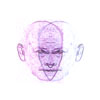 For an album that is right at forty-six minutes long, it sure does seemto last an enternity. The entire record is basically a series of tonesaccompanied by various passages concerned with or describing sexualperversions. At first this seemed like an exciting enough prospect:Andrew Liles associates Aural Anagramwith the various productions of Hans Bellmer. Bellmer was one of thefirst post-Dada surrealists, his self-portrait appears on the cover andI assume that the artwork in the liner notes is either inspired ordrawn by him. The primary sketch on the liner notes depicts a nudewoman on her hands and knees with her lower torso "x-rayed" to revealher womb and sexual organs. At the same time, she is pleasuring threedifferent men who are shown only by the presence of their penis. It's astrange image to be sure, but none of the sexuality in the picturemakes it into the music in any way. Each track sounds remarkably thesame with various vocal samples describing various perversities orsexual observations made from a nearly medical standpoint. Nothingchanges throughout the duration of the recording: many of the tonesused have the same color and feel throughout and much of the vocalsamples simply repeat themselves into boring oblivion. It sounds morelike one long recording than a series of nine compositions inspired byan explicit artist. It may be my hormones talking, but with a premisslike this, the album certainly could've been more exciting and retainedits rather dark and ominous atmosphere. In the end, that is what makeseverything about this recording so dull: it's too dark for too long andwith little to no variation in the bleakness of it all. It's aninteresting exploration of an artist and an idea but it fails as acomposition as a result of being far too limited in scope.
For an album that is right at forty-six minutes long, it sure does seemto last an enternity. The entire record is basically a series of tonesaccompanied by various passages concerned with or describing sexualperversions. At first this seemed like an exciting enough prospect:Andrew Liles associates Aural Anagramwith the various productions of Hans Bellmer. Bellmer was one of thefirst post-Dada surrealists, his self-portrait appears on the cover andI assume that the artwork in the liner notes is either inspired ordrawn by him. The primary sketch on the liner notes depicts a nudewoman on her hands and knees with her lower torso "x-rayed" to revealher womb and sexual organs. At the same time, she is pleasuring threedifferent men who are shown only by the presence of their penis. It's astrange image to be sure, but none of the sexuality in the picturemakes it into the music in any way. Each track sounds remarkably thesame with various vocal samples describing various perversities orsexual observations made from a nearly medical standpoint. Nothingchanges throughout the duration of the recording: many of the tonesused have the same color and feel throughout and much of the vocalsamples simply repeat themselves into boring oblivion. It sounds morelike one long recording than a series of nine compositions inspired byan explicit artist. It may be my hormones talking, but with a premisslike this, the album certainly could've been more exciting and retainedits rather dark and ominous atmosphere. In the end, that is what makeseverything about this recording so dull: it's too dark for too long andwith little to no variation in the bleakness of it all. It's aninteresting exploration of an artist and an idea but it fails as acomposition as a result of being far too limited in scope. samples:
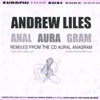 On the other hand, the remix album included with the first one-hundred copies of Aural Anagramis a more cohesive, varied, and interesting exploration of droningsounds and sexual expression. Instead of being a series of nine trackslike the original was, Anal Aura Gram is four tracks tiedtogether very closely so that the recording can be experienced as awhole. By cutting the album down by ten minutes and condensing much ofthe original material, Liles creates an almost deafening world. Itisn't deafening because it's overly loud or overpowering in any way,it's just that the sounds used produce the aural equivalent ofclaustrophobia. Every sound has a tactitle quality, whether it isfeathery softness or the cold feeling of making a discomfortingobservation. More melodic elements are present than on the original andnot so much time is devoted to near-silence or frustrating repetition.The vocal samples are used more sparingly and multiple textures areused throughout so that nothing overstays its welcome. This sort ofattention to detail adds to the eerie and dire feelings that wereattempted on the original mix: various melodic tones float like bubblesand are flourished by rolling sparkles in piano-like ascents anddescents. Small buzz-saws cut away quietly in the background whileother alien sounds stutter and chop their away across the soundspectrum. Here and there feminine moans and abrupt cries appear anddisappear within the mix creating a vaguely erotic tension whilemaintaining a secretive tone that hints at violence, destruction, and(somehow) infidelity. There are fewer overtly sexual references made,but the ones used are both exciting and unsettling. The remixes areeverything Aural Anagram could've (and should've) been, so those interested should grab a copy before they all disappear.
On the other hand, the remix album included with the first one-hundred copies of Aural Anagramis a more cohesive, varied, and interesting exploration of droningsounds and sexual expression. Instead of being a series of nine trackslike the original was, Anal Aura Gram is four tracks tiedtogether very closely so that the recording can be experienced as awhole. By cutting the album down by ten minutes and condensing much ofthe original material, Liles creates an almost deafening world. Itisn't deafening because it's overly loud or overpowering in any way,it's just that the sounds used produce the aural equivalent ofclaustrophobia. Every sound has a tactitle quality, whether it isfeathery softness or the cold feeling of making a discomfortingobservation. More melodic elements are present than on the original andnot so much time is devoted to near-silence or frustrating repetition.The vocal samples are used more sparingly and multiple textures areused throughout so that nothing overstays its welcome. This sort ofattention to detail adds to the eerie and dire feelings that wereattempted on the original mix: various melodic tones float like bubblesand are flourished by rolling sparkles in piano-like ascents anddescents. Small buzz-saws cut away quietly in the background whileother alien sounds stutter and chop their away across the soundspectrum. Here and there feminine moans and abrupt cries appear anddisappear within the mix creating a vaguely erotic tension whilemaintaining a secretive tone that hints at violence, destruction, and(somehow) infidelity. There are fewer overtly sexual references made,but the ones used are both exciting and unsettling. The remixes areeverything Aural Anagram could've (and should've) been, so those interested should grab a copy before they all disappear.samples:
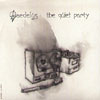 The Quiet Party is a re-mix EP of tracks from Los Angeles avant-garde hip hop producer Daedelus' Inventiondisc, including interpretations from the good company of producer/DJMadlib, the Antipop Consortium's High Priest, along with MCs AbstractRude and The Weather's Busdriver. Opening up the disc, "Playing Parties(Yesterdays New Quintet The Stars Remix)" sees Madlib mixing loose,jazzy drums and percussion with a repeating, dreamy piano progression,peppered with a minimal, controlled overdriven melody, upright bassstring slides and assorted bips and bleeps for an overall warmingtrack. Choppy drum machine and quirky keyboard patterns move "MuggleBorn (High Priest ESP Remix)" along for the Priest to convey hissignatory, precise rhymes and rhythms. "Girls" has Abstract Rude andBusdriver trading rhymes to swoon the ladies with over a backing trackof lounge/exotica motifs nailed down by tight beats and the "shoop" ofopen hi-hats, all topped off with orchestral string swells. Availableonly of the CD version of this EP, Daedelus' "A Touch of Spring" mixesearly 60's kitchy big band with a TV show soundtrack-styled feel to afamiliar 80's synth-pop riff that still has me smirking - all set tosharp drumkit samples. Daedulus' interesting and recognizablecompositional style is not only solid on its own, but also stands tooffer up great source material.
The Quiet Party is a re-mix EP of tracks from Los Angeles avant-garde hip hop producer Daedelus' Inventiondisc, including interpretations from the good company of producer/DJMadlib, the Antipop Consortium's High Priest, along with MCs AbstractRude and The Weather's Busdriver. Opening up the disc, "Playing Parties(Yesterdays New Quintet The Stars Remix)" sees Madlib mixing loose,jazzy drums and percussion with a repeating, dreamy piano progression,peppered with a minimal, controlled overdriven melody, upright bassstring slides and assorted bips and bleeps for an overall warmingtrack. Choppy drum machine and quirky keyboard patterns move "MuggleBorn (High Priest ESP Remix)" along for the Priest to convey hissignatory, precise rhymes and rhythms. "Girls" has Abstract Rude andBusdriver trading rhymes to swoon the ladies with over a backing trackof lounge/exotica motifs nailed down by tight beats and the "shoop" ofopen hi-hats, all topped off with orchestral string swells. Availableonly of the CD version of this EP, Daedelus' "A Touch of Spring" mixesearly 60's kitchy big band with a TV show soundtrack-styled feel to afamiliar 80's synth-pop riff that still has me smirking - all set tosharp drumkit samples. Daedulus' interesting and recognizablecompositional style is not only solid on its own, but also stands tooffer up great source material.samples:
 I call it smooth and sickeningly so. The lyrics go down easy, the beatsfloat like a bed of feathers, and the melodies are maddeningly similarthroughout the entire album. Try meshing together the sounds of hip-hopand some fragments of 70s, 80s, and 90s pop and rock music (it's reallya very easy thing to imagine) and what might emerge is something likeBrassy. There's some funky bass rhythms that twitch and gallop here andthere and some of the beats are truly infectious but those damn vocalsare like police sirens just when I thought I'd gotten away with it.It's not that the vocals aren't performed by a talentless group ofperformers, it's just that the content is empty, repetitive, andusually far too giddy. On "Where Did You Get That Funk?" the title isrepeated a few times during the chorus while a frighteningly cleanrhythm accentuated by cleverly placed bass slaps brings to mind imagesof various creatures dancing in place somewhere within Willy Wonka'sChocolate Factory. It's hilarious to think about when the music isn't playing.Sitting through the music is a chore and after about the fourth songeverything bleeds together and ends up sound exactly the same. Whilethere are some enjoyable moments, the general attitude of every songmakes me wonder why this group hasn't appeared on a certain televisionstation and taken home ten or twelve awards yearly. Maybe I'm being abit harsh. There is, after all a minute and twelve seconds ofdistinctive rest called "Swett's Muse." In addition, "Gettin Wise" doesmanage to convey its freakiness without sending me over the edge ofsanity (at least I don't immediately reach for the skip button). By themiddle of the album, however, I was capable of predicting exactly whateach track was going to sound like. It's catchy, it's sort of funky(though in a very clean way), and is easy to swallow but it also wearsits welcome out very quickly.
I call it smooth and sickeningly so. The lyrics go down easy, the beatsfloat like a bed of feathers, and the melodies are maddeningly similarthroughout the entire album. Try meshing together the sounds of hip-hopand some fragments of 70s, 80s, and 90s pop and rock music (it's reallya very easy thing to imagine) and what might emerge is something likeBrassy. There's some funky bass rhythms that twitch and gallop here andthere and some of the beats are truly infectious but those damn vocalsare like police sirens just when I thought I'd gotten away with it.It's not that the vocals aren't performed by a talentless group ofperformers, it's just that the content is empty, repetitive, andusually far too giddy. On "Where Did You Get That Funk?" the title isrepeated a few times during the chorus while a frighteningly cleanrhythm accentuated by cleverly placed bass slaps brings to mind imagesof various creatures dancing in place somewhere within Willy Wonka'sChocolate Factory. It's hilarious to think about when the music isn't playing.Sitting through the music is a chore and after about the fourth songeverything bleeds together and ends up sound exactly the same. Whilethere are some enjoyable moments, the general attitude of every songmakes me wonder why this group hasn't appeared on a certain televisionstation and taken home ten or twelve awards yearly. Maybe I'm being abit harsh. There is, after all a minute and twelve seconds ofdistinctive rest called "Swett's Muse." In addition, "Gettin Wise" doesmanage to convey its freakiness without sending me over the edge ofsanity (at least I don't immediately reach for the skip button). By themiddle of the album, however, I was capable of predicting exactly whateach track was going to sound like. It's catchy, it's sort of funky(though in a very clean way), and is easy to swallow but it also wearsits welcome out very quickly.samples:
 Expanding on and experimenting with a given style is an artist's right.Just ask John Zorn. But what happens when an influential artists delvesinto unoriginal, boring territory? Take Pole as an obvious example.Stefan Betke's first three releases embodied a minimalist, asceticaesthetic, from the atmospheric crackles of his broken Walfdorf 4-Polefilter unit to the album names themselves. Though he may not haveinvented the notion of incorporating static sounds into a dubframework, he clearly spearheaded the musical trend that would take onsuch names as "clicks and cuts" and "glitch." By his '3' album,however, many critics felt that Betke was a one trick pony, havingmaxxed out the potential of his style. So naturally we should expectthe artist to expand and experiment. After the stylistic cues of hisrecent '90/90' and '45/45' EPs, as well as the eclectic themecompilations on his ~scape imprint, the sound of his latest full-lengthshould not surprise those who have been keeping up. Still, that doesn'tmean we shouldn't feel disappointed. Here's an artist who could havepotentially added more organic roots and reggae elements into hismusic, progressing further in the natural direction his music hadseemed to take after the first trilogy. Insteaad, we get a starkdigression, where the underlying pops and crackles have been wipedclean and out-of-place percussive, instrumental, and even vocalelements have been included. A long way down the road from the glitchmovement, this self-title album reeks of pandering to a crossover indiehip hop scene without the b-boy comprehension of a Prefuse 73 or aDabrye. Def Poetry riffs from rapper Fat Jon come across awkward andlost over Betke's uneasy new musical failure. In layman's terms, Itried to like this. Really. I did. But it sucks. It just sucks.
Expanding on and experimenting with a given style is an artist's right.Just ask John Zorn. But what happens when an influential artists delvesinto unoriginal, boring territory? Take Pole as an obvious example.Stefan Betke's first three releases embodied a minimalist, asceticaesthetic, from the atmospheric crackles of his broken Walfdorf 4-Polefilter unit to the album names themselves. Though he may not haveinvented the notion of incorporating static sounds into a dubframework, he clearly spearheaded the musical trend that would take onsuch names as "clicks and cuts" and "glitch." By his '3' album,however, many critics felt that Betke was a one trick pony, havingmaxxed out the potential of his style. So naturally we should expectthe artist to expand and experiment. After the stylistic cues of hisrecent '90/90' and '45/45' EPs, as well as the eclectic themecompilations on his ~scape imprint, the sound of his latest full-lengthshould not surprise those who have been keeping up. Still, that doesn'tmean we shouldn't feel disappointed. Here's an artist who could havepotentially added more organic roots and reggae elements into hismusic, progressing further in the natural direction his music hadseemed to take after the first trilogy. Insteaad, we get a starkdigression, where the underlying pops and crackles have been wipedclean and out-of-place percussive, instrumental, and even vocalelements have been included. A long way down the road from the glitchmovement, this self-title album reeks of pandering to a crossover indiehip hop scene without the b-boy comprehension of a Prefuse 73 or aDabrye. Def Poetry riffs from rapper Fat Jon come across awkward andlost over Betke's uneasy new musical failure. In layman's terms, Itried to like this. Really. I did. But it sucks. It just sucks. samples:
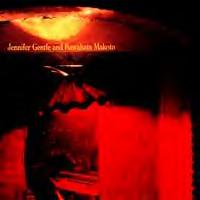 Jennifer Gentle's newest release is a live disc documenting a 2002 show in their native Italy during which they were joined on stage by the irrepressible Kawabata Makoto of Acid Mothers Temple. I'm not sure what, if anything, Makoto's monolithic acid-guitar stylings have in common with Jennifer Gentle's eclectic psych-pop. Perhaps nothing, but once the opening drones begin all such questions melt away.
Jennifer Gentle's newest release is a live disc documenting a 2002 show in their native Italy during which they were joined on stage by the irrepressible Kawabata Makoto of Acid Mothers Temple. I'm not sure what, if anything, Makoto's monolithic acid-guitar stylings have in common with Jennifer Gentle's eclectic psych-pop. Perhaps nothing, but once the opening drones begin all such questions melt away.
 Italian music listeners seem to have an enduring interest in rare psychedelic, progressive and kosmische music from the late 60's and 70's. There is a clutch of Italian labels like Akarma, Comet and Horizon that tirelessly pump out deluxe reissues of obscure chestnuts from America and Europe's recent rock past. Not surprisingly, a number of new groups have come out of Italy in the last few years that owe a tremendous debt to this tradition of psychedelic esoterica.
Italian music listeners seem to have an enduring interest in rare psychedelic, progressive and kosmische music from the late 60's and 70's. There is a clutch of Italian labels like Akarma, Comet and Horizon that tirelessly pump out deluxe reissues of obscure chestnuts from America and Europe's recent rock past. Not surprisingly, a number of new groups have come out of Italy in the last few years that owe a tremendous debt to this tradition of psychedelic esoterica.
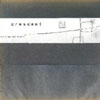 Comprised of members of both Movietone and Flying Saucer Attack,Crescent was born of the spacy post-rock scene that arose from Bristolin the mid-1990s. Vastly less interesting than either of those bands,Crescent has released a small handful of recordings since itsinception. Their latest, and first for Fat Cat, recalls the playfulorgan melodies and percussion of Pram; the slightly trippy, moody brassinflections of Legendary Pink Dots; and the mournful, jarring vocals ofJoy Division. This may sound like a great formula, but somehow Crescentjust doesn't pull it off. Overall, the raw, rough sound of By the Roads and the Fieldsmakes for a thought-provoking atmosphere, but ultimately does notcontribute anything to make the album compelling. The vocals of MattJones in particular tend to drag the music down. His monotone, sullenpresentation of the ponderous lyrics makes them far too heavy for thealbum's strong point, the sparse instrumentation. "Mica," the besttrack, seems to be so largely due to the fact that it doesn't havevocals on it. Devotees of Flying Saucer Attack and the subsequentprojects it spawned would be wise to wait for this fall's forthcomingMovietone record rather than pick up Crescent's latest offering.
Comprised of members of both Movietone and Flying Saucer Attack,Crescent was born of the spacy post-rock scene that arose from Bristolin the mid-1990s. Vastly less interesting than either of those bands,Crescent has released a small handful of recordings since itsinception. Their latest, and first for Fat Cat, recalls the playfulorgan melodies and percussion of Pram; the slightly trippy, moody brassinflections of Legendary Pink Dots; and the mournful, jarring vocals ofJoy Division. This may sound like a great formula, but somehow Crescentjust doesn't pull it off. Overall, the raw, rough sound of By the Roads and the Fieldsmakes for a thought-provoking atmosphere, but ultimately does notcontribute anything to make the album compelling. The vocals of MattJones in particular tend to drag the music down. His monotone, sullenpresentation of the ponderous lyrics makes them far too heavy for thealbum's strong point, the sparse instrumentation. "Mica," the besttrack, seems to be so largely due to the fact that it doesn't havevocals on it. Devotees of Flying Saucer Attack and the subsequentprojects it spawned would be wise to wait for this fall's forthcomingMovietone record rather than pick up Crescent's latest offering.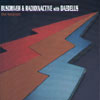 Asthe Weather, Los Angeles MCs Busdriver and Radioinactive dispense quickcut, weaving and rapid-fire rhymes with free-association styled contentranging from humorous to brilliant. Along with sample-basedcompositions and production from studio ace Daedelus, the trio havecollaborated on The Weather for sixty minutes of blisteringrhymes and hip hop meets clever musical arrangements, wierdness andsatire. "Pen's Oil" opens with a 18's inspired orchestration set tofunky drums and laid-back piano riffing that shifts to double time tokeep up with the speedy vocal dispatching. The playfully titled "CarlWeathers" consists of a full backing that includes machine beats,percussion and upright bass with a chorus that sings a line from atypical weather report while the duo convey simultaneous rhymes andbreak away for individual segments. A sampled audience clapping outsyncopated rhythms sets "Fine For A Robot" in motion for a soulfultrack when Busdriver, tongue in cheek, beautifully sings a loving odeto a machine. It then switches to drums and piano flourishes whenRadioinactive gets the sassy rhymes going for the robot girl. Daedelus'production on "Raffle Ticket Blues" employs dark, minor key jazz piano,bass and brushed drums segments with tinny machine beats forRadioinactive's wordplay in which the piece's sections are clearlymarked off based on the words per minute. The Weather's interestinglyrics and vocal talents of leaving no space unfilled are equallymatched by their ability to let lines breathe by leaving space betweenwords; all complemented nicely by Daedelus' rhythmic soundmanipulation.
Asthe Weather, Los Angeles MCs Busdriver and Radioinactive dispense quickcut, weaving and rapid-fire rhymes with free-association styled contentranging from humorous to brilliant. Along with sample-basedcompositions and production from studio ace Daedelus, the trio havecollaborated on The Weather for sixty minutes of blisteringrhymes and hip hop meets clever musical arrangements, wierdness andsatire. "Pen's Oil" opens with a 18's inspired orchestration set tofunky drums and laid-back piano riffing that shifts to double time tokeep up with the speedy vocal dispatching. The playfully titled "CarlWeathers" consists of a full backing that includes machine beats,percussion and upright bass with a chorus that sings a line from atypical weather report while the duo convey simultaneous rhymes andbreak away for individual segments. A sampled audience clapping outsyncopated rhythms sets "Fine For A Robot" in motion for a soulfultrack when Busdriver, tongue in cheek, beautifully sings a loving odeto a machine. It then switches to drums and piano flourishes whenRadioinactive gets the sassy rhymes going for the robot girl. Daedelus'production on "Raffle Ticket Blues" employs dark, minor key jazz piano,bass and brushed drums segments with tinny machine beats forRadioinactive's wordplay in which the piece's sections are clearlymarked off based on the words per minute. The Weather's interestinglyrics and vocal talents of leaving no space unfilled are equallymatched by their ability to let lines breathe by leaving space betweenwords; all complemented nicely by Daedelus' rhythmic soundmanipulation.  Journalists invent music sub-genres when they get tired of comparingmusical artists to another musical act. While Icelander OlafurJosephsson is once again showcasing his amazing playing, arrangement,and compositional talents for his second full-length disc as StafrænHákon, it's painfully difficult to escape the comparisons to Mogwai.(In addition, it's rather ironic than Josephsson now makes Glasgow hishome.) All of his music is instrumental once again on this, his firstrelease to be put out through somebody other than himself. For tensongs, the guitar and effects-driven melodies are a blissful wash ofdrifting audio landscapes. It's quite easy to get completely lost inthe music's beauty. Numerous songs like "Tætir rækju" pulse with asubtle beat and move within somewhat predictable, and enjoyable whilebeat-less tunes like "Grifflur" are chilling and turbulent like thebright moonlight reflecting off of cold, icy waters. With the additionof organic drum work and chiming sounds, however, songs like the closer"Safi" are unmistakably resemblant of Mogwai's tunes from their EP +release. There's nothing unpleasant about any of the songs, but what'slacking perhaps is an element of the unexpected, the unpredictabile, orchaos. There's so much that can be done with this music, but Josephssonchooses a route which leaves most of the music completely as is. Whileit may reduce the chances of being accused of being gimmicky, it doessound derivative. Skvettir Edik à Ref is a good second albumand will surely please a ton of fans of the more gentle side ofinstrumental guitar music. There is a load of potential for StefrænHákon to be amazing but it's just not quite at that level yet.
Journalists invent music sub-genres when they get tired of comparingmusical artists to another musical act. While Icelander OlafurJosephsson is once again showcasing his amazing playing, arrangement,and compositional talents for his second full-length disc as StafrænHákon, it's painfully difficult to escape the comparisons to Mogwai.(In addition, it's rather ironic than Josephsson now makes Glasgow hishome.) All of his music is instrumental once again on this, his firstrelease to be put out through somebody other than himself. For tensongs, the guitar and effects-driven melodies are a blissful wash ofdrifting audio landscapes. It's quite easy to get completely lost inthe music's beauty. Numerous songs like "Tætir rækju" pulse with asubtle beat and move within somewhat predictable, and enjoyable whilebeat-less tunes like "Grifflur" are chilling and turbulent like thebright moonlight reflecting off of cold, icy waters. With the additionof organic drum work and chiming sounds, however, songs like the closer"Safi" are unmistakably resemblant of Mogwai's tunes from their EP +release. There's nothing unpleasant about any of the songs, but what'slacking perhaps is an element of the unexpected, the unpredictabile, orchaos. There's so much that can be done with this music, but Josephssonchooses a route which leaves most of the music completely as is. Whileit may reduce the chances of being accused of being gimmicky, it doessound derivative. Skvettir Edik à Ref is a good second albumand will surely please a ton of fans of the more gentle side ofinstrumental guitar music. There is a load of potential for StefrænHákon to be amazing but it's just not quite at that level yet. 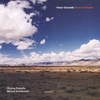 Combining cultural (i.e., traditional) instrumentation and phrasingwith more contemporary music always ends up producing something far toonew age and cheesey. It's a shame, especially when left as seperateentities, each can be quite gorgeous and ear-opening. Victor Chorobikand company have attempted to fuse various Tibetan sounds with those ofjazz and classical descent. The results are, at best, mixed andself-limiting. Exotic flutes are mixed with soprano and tenorsaxophones and each makes the other stand out like a sore thumb: thetwo simply don't fuse as well as the musicians would like to think.Lengthy tracks are accompanied by endlessly repeating drum patternswhile easy-going and laid back melodies shine over them, only themelodies aren't all that exciting or attention-grabbing. When thetraditional instrumentation and structures are left to themselves theresults are a little different. Chants, spoken-word passages, woodenflutes, and various guitars all mix to form something that borders onthe spiritual; they at least sound as if they are of a religiousbackground. Repeated listens will reveal that the native instrumentsare never truly left alone, however. There's always a keyboard of somekind attempting to add to the mystery and awe that native (or justplain alien) music, when completely naked, so often has the power ofevoking. The result is a pure stinking cheese that sucks the life outof the source material. This is nowhere more evident than on "Mantra ofGuru Rinpoche." A lone chant is performed only to be interrupted by acompletely pointless combination of shimmering keyboard sounds and lowbass throbbings. I've never been a big fan of these kinds of culturalcrossings precisely because they rob the uniqueness out of eachother.That's not to say that every single one of them are doomed to failure,but hearing the original stuff as documented in the field always endsup inspiring me more than what is meticulously calculated andconsidered within the studio. There is some beauty to be found here,but be prepared to be offended along the way. -
Combining cultural (i.e., traditional) instrumentation and phrasingwith more contemporary music always ends up producing something far toonew age and cheesey. It's a shame, especially when left as seperateentities, each can be quite gorgeous and ear-opening. Victor Chorobikand company have attempted to fuse various Tibetan sounds with those ofjazz and classical descent. The results are, at best, mixed andself-limiting. Exotic flutes are mixed with soprano and tenorsaxophones and each makes the other stand out like a sore thumb: thetwo simply don't fuse as well as the musicians would like to think.Lengthy tracks are accompanied by endlessly repeating drum patternswhile easy-going and laid back melodies shine over them, only themelodies aren't all that exciting or attention-grabbing. When thetraditional instrumentation and structures are left to themselves theresults are a little different. Chants, spoken-word passages, woodenflutes, and various guitars all mix to form something that borders onthe spiritual; they at least sound as if they are of a religiousbackground. Repeated listens will reveal that the native instrumentsare never truly left alone, however. There's always a keyboard of somekind attempting to add to the mystery and awe that native (or justplain alien) music, when completely naked, so often has the power ofevoking. The result is a pure stinking cheese that sucks the life outof the source material. This is nowhere more evident than on "Mantra ofGuru Rinpoche." A lone chant is performed only to be interrupted by acompletely pointless combination of shimmering keyboard sounds and lowbass throbbings. I've never been a big fan of these kinds of culturalcrossings precisely because they rob the uniqueness out of eachother.That's not to say that every single one of them are doomed to failure,but hearing the original stuff as documented in the field always endsup inspiring me more than what is meticulously calculated andconsidered within the studio. There is some beauty to be found here,but be prepared to be offended along the way. - 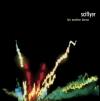 It used to be that when a band was called shoegazer music it was descriptive enough to illustrate exactly what someone would hear when they put the album on. These days, there are so many bands recording music that passes as shoegazer that it's almost evolved into another genre entirely, and none of it really resembles the original sound. Unfortunately, most of the bands in this genre possess little originality and more than their fair share of mediocrity. Sciflyer, hot off two self-released EPs, prove on their debut that there is still a chance for this kind of music while also displaying everything that's wrong with the psychedelic rock scene.
It used to be that when a band was called shoegazer music it was descriptive enough to illustrate exactly what someone would hear when they put the album on. These days, there are so many bands recording music that passes as shoegazer that it's almost evolved into another genre entirely, and none of it really resembles the original sound. Unfortunately, most of the bands in this genre possess little originality and more than their fair share of mediocrity. Sciflyer, hot off two self-released EPs, prove on their debut that there is still a chance for this kind of music while also displaying everything that's wrong with the psychedelic rock scene.
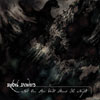 In the office where I worked this summer, the main lobby featured anenormous piece by artist Frank Stella. The piece was large, probablytwenty feet tall, and consisted of a series of colored boxes, enclosedin a thick orange boarded and symmetrically mirrored on the oppositeside. These are the kind of works, abstract shapes and colors, thatmade Stella and his minimalist style known in the art world. Everymorning I would step off the elevators and be cast in the imaginaryshadow of this walled piece, unable to ignore it, and think to myself,"Is it me, or is this a total fraud?" I'm no art critic, but for me thepiece did nothing. It evoked no feelings and no deep thoughts, only theconfusion that a crayola palette and attention to straight lines couldto some extent, make one renowned. So excuse me for being somewhat warywhen Rebel Powers was described to me as minimalist. Rebel Powers is acollaboration between Acid Mothers Temple's Kawabata Makoto, CottonCasino, Koizumi Hajime and Telstar Ponies' David Keenan. Thesemusicians came together to perform two long instrumental tracks, withonly incidental overdubbing to create what they identify as minimalistexcursions. "We Are For the Dark" is the first volley, and quicklydispelled my initial fears. Guitars drone against each other as ghastlymoans supplied by a sarangi, a classical Indian bowed instrument.Percussion drips in and out of the shambling piece as it oozes forward.The darkness Rebel Powers aims to provide is very apparent, and "We AreFor the Dark" lays out in its patient tones a spooky, malevolentatmosphere that only builds in intensty and effectiveness as the trackcontinues. The instruments seem to grind against one another like therusty components of a machine lurching to life and slowly gaining backits momentum and force. Errant shards of noise shoot out into the stewbefore disappearing beneath it. In the tail end of its long duration,the improvisation reaches a more insistent peak before petering out ina collision of clangs and dwindling washes. The track is not spare orsparse, and never does it feel overly repetitive (though in essence ittreads the same core for twenty five minutes) or boring. It has a depthand body that draws you in and wraps you up in the imagery; it doesn'tleave you staring at it confounded. Unfortunately, the next track isnot nearly as successful. "Our God is A Mighty Fortress" mills aboutaimlessly over a repetitive pattern for far too long. While the firsttrack transported me to dark forests, rain soaked dirt roads andlurking unknowns in the brush just behind, the second track brings meright back to my office, staring up at the Stella and wondering tomyself what the big deal is. As the track progresses, it does improveslightly, with a more clean, more relaxed attitude than the first, butthe loss of energy and excitement that the first ten minutes or so is adevastating hit to the whole. Had the tracks been reversed in order, Imay have been more forgiving, but the ideas as presented took the windout of my enthusiasm. Such is the risk with improvised music. Sometimesideas don't pan out and paths taken more often lead to dead ends thanexplosions of brilliance, but when they do the trip is entirely worthit. As demonstrated by Rebel Powers, minimalism can mean more thaneconomy, and bleak can be busy, but that asceticism is a trap that isdifficult to escape.
In the office where I worked this summer, the main lobby featured anenormous piece by artist Frank Stella. The piece was large, probablytwenty feet tall, and consisted of a series of colored boxes, enclosedin a thick orange boarded and symmetrically mirrored on the oppositeside. These are the kind of works, abstract shapes and colors, thatmade Stella and his minimalist style known in the art world. Everymorning I would step off the elevators and be cast in the imaginaryshadow of this walled piece, unable to ignore it, and think to myself,"Is it me, or is this a total fraud?" I'm no art critic, but for me thepiece did nothing. It evoked no feelings and no deep thoughts, only theconfusion that a crayola palette and attention to straight lines couldto some extent, make one renowned. So excuse me for being somewhat warywhen Rebel Powers was described to me as minimalist. Rebel Powers is acollaboration between Acid Mothers Temple's Kawabata Makoto, CottonCasino, Koizumi Hajime and Telstar Ponies' David Keenan. Thesemusicians came together to perform two long instrumental tracks, withonly incidental overdubbing to create what they identify as minimalistexcursions. "We Are For the Dark" is the first volley, and quicklydispelled my initial fears. Guitars drone against each other as ghastlymoans supplied by a sarangi, a classical Indian bowed instrument.Percussion drips in and out of the shambling piece as it oozes forward.The darkness Rebel Powers aims to provide is very apparent, and "We AreFor the Dark" lays out in its patient tones a spooky, malevolentatmosphere that only builds in intensty and effectiveness as the trackcontinues. The instruments seem to grind against one another like therusty components of a machine lurching to life and slowly gaining backits momentum and force. Errant shards of noise shoot out into the stewbefore disappearing beneath it. In the tail end of its long duration,the improvisation reaches a more insistent peak before petering out ina collision of clangs and dwindling washes. The track is not spare orsparse, and never does it feel overly repetitive (though in essence ittreads the same core for twenty five minutes) or boring. It has a depthand body that draws you in and wraps you up in the imagery; it doesn'tleave you staring at it confounded. Unfortunately, the next track isnot nearly as successful. "Our God is A Mighty Fortress" mills aboutaimlessly over a repetitive pattern for far too long. While the firsttrack transported me to dark forests, rain soaked dirt roads andlurking unknowns in the brush just behind, the second track brings meright back to my office, staring up at the Stella and wondering tomyself what the big deal is. As the track progresses, it does improveslightly, with a more clean, more relaxed attitude than the first, butthe loss of energy and excitement that the first ten minutes or so is adevastating hit to the whole. Had the tracks been reversed in order, Imay have been more forgiving, but the ideas as presented took the windout of my enthusiasm. Such is the risk with improvised music. Sometimesideas don't pan out and paths taken more often lead to dead ends thanexplosions of brilliance, but when they do the trip is entirely worthit. As demonstrated by Rebel Powers, minimalism can mean more thaneconomy, and bleak can be busy, but that asceticism is a trap that isdifficult to escape.  This album is staggering in its creativity, even though it's probablythe most pop-focused of Rollerball's releases. They bring the funkinfluence, which has always been lurking, closer to the fore quitetastefully, with propulsive drums and full-bodied bass inspiringmovement, but the highlight of their music is definitely thesuper-catchy lyrics and melodies. Stabbing, anthemic horn leads andsmoky piano lines accompany their vaguely dadaist cabaret vocals,singing seemingly lighthearted verses about clarinet samples and ourforefathers wearing drag, but the sense of tension that their dramaticpresentation inspires is remarkable. Rollerball's little details oforganic experimentation and everything-including-the-kitchen-sinknoisemaking are still present in some form, but they're more tightlywoven into the songs themselves, such that the album is full ofinteresting sounds throughout, but free from gratuitously tacked onelements. Still, this is a far cry from the extended free-noise oftheir earlier works. Tracks like "66 Deadhead Spies" and "Starling"play up the loungey aspects—shared male/female vocals and slick pianoinstrumentation; while a steady bassline anchors "Mike's Hind," thesole instrumental piece, as various sound effects and improvisedphrases float through the mix. "Spine Delay" seems to be a shout out toall dudes in the audience with its deranged, at times hyper-falsetto,singing, until the horror-movie organ emerges and the band settles on amellow groove. The album ends with a suitably incomprehensible spokenword piece about nature. Rollerball are an entertaining and interestingband, and it's great to hear further development of their refreshinglyunique pop music.
This album is staggering in its creativity, even though it's probablythe most pop-focused of Rollerball's releases. They bring the funkinfluence, which has always been lurking, closer to the fore quitetastefully, with propulsive drums and full-bodied bass inspiringmovement, but the highlight of their music is definitely thesuper-catchy lyrics and melodies. Stabbing, anthemic horn leads andsmoky piano lines accompany their vaguely dadaist cabaret vocals,singing seemingly lighthearted verses about clarinet samples and ourforefathers wearing drag, but the sense of tension that their dramaticpresentation inspires is remarkable. Rollerball's little details oforganic experimentation and everything-including-the-kitchen-sinknoisemaking are still present in some form, but they're more tightlywoven into the songs themselves, such that the album is full ofinteresting sounds throughout, but free from gratuitously tacked onelements. Still, this is a far cry from the extended free-noise oftheir earlier works. Tracks like "66 Deadhead Spies" and "Starling"play up the loungey aspects—shared male/female vocals and slick pianoinstrumentation; while a steady bassline anchors "Mike's Hind," thesole instrumental piece, as various sound effects and improvisedphrases float through the mix. "Spine Delay" seems to be a shout out toall dudes in the audience with its deranged, at times hyper-falsetto,singing, until the horror-movie organ emerges and the band settles on amellow groove. The album ends with a suitably incomprehensible spokenword piece about nature. Rollerball are an entertaining and interestingband, and it's great to hear further development of their refreshinglyunique pop music. The second of the Anomalous co-releases is an oddly indefinable, "accidental" remix of Nurse With Wound's first album Chance Meeting on a Dissecting Table of a Sewing Machine and an Umbrella by Matt Waldron of irr.(app.)ext. Chance Meetingis a landmark record of deranged psychedelic proto-industrialexperimentation. Matt Waldron's irr.(app.)ext. has produced some of themost exciting audio surrealism to come along in recent years. However,this disc is not the meeting of these two great minds that one mightexpect. As the story goes, Waldron was making a tape-to-tape dupe ofthe original United Dairies cassette, when his dysfunctional taperecorder began to warp and mutate the source material, producing itsown interpolation of the Nurse classic. This kind of accidentallydeteriorating tape idea has recently been used to much more subtle andingenius effect on William Basinski's Disintegration Loops series.Although I can imagine that the warbles and mutations caused by thistape recorder mishap might have appealed to Matt Waldron and StevenStapleton, its pleasures are truly ephemeral. All the CD boils down tois an inferior, hiss-heavy transfer of the original album, with somerandom time-stretching, glitches and wobbles that do very little toincrease interest for the listener. Although I admire the love foraccident and synchronicity that led Stapleton and Waldron to releasethis material, I don't think that it will hold much interest for theaverage listener. This review certainly won't discourage those whoobsessively collect everything issued from the Nurse With Wound camp.But for those who are just a little more selective about this stuff, Ithink I can safely suggest that you steer clear of this unique butultimately inane piece of conceptual audio.
The second of the Anomalous co-releases is an oddly indefinable, "accidental" remix of Nurse With Wound's first album Chance Meeting on a Dissecting Table of a Sewing Machine and an Umbrella by Matt Waldron of irr.(app.)ext. Chance Meetingis a landmark record of deranged psychedelic proto-industrialexperimentation. Matt Waldron's irr.(app.)ext. has produced some of themost exciting audio surrealism to come along in recent years. However,this disc is not the meeting of these two great minds that one mightexpect. As the story goes, Waldron was making a tape-to-tape dupe ofthe original United Dairies cassette, when his dysfunctional taperecorder began to warp and mutate the source material, producing itsown interpolation of the Nurse classic. This kind of accidentallydeteriorating tape idea has recently been used to much more subtle andingenius effect on William Basinski's Disintegration Loops series.Although I can imagine that the warbles and mutations caused by thistape recorder mishap might have appealed to Matt Waldron and StevenStapleton, its pleasures are truly ephemeral. All the CD boils down tois an inferior, hiss-heavy transfer of the original album, with somerandom time-stretching, glitches and wobbles that do very little toincrease interest for the listener. Although I admire the love foraccident and synchronicity that led Stapleton and Waldron to releasethis material, I don't think that it will hold much interest for theaverage listener. This review certainly won't discourage those whoobsessively collect everything issued from the Nurse With Wound camp.But for those who are just a little more selective about this stuff, Ithink I can safely suggest that you steer clear of this unique butultimately inane piece of conceptual audio.  The English esoteric artists Current 93, Nurse With Wound and Coil —recently canonized in David Keenan's England's Hidden Reverse — areobviously intelligent, always creative, and often revolutionary. Ifanything bad could be said about these artists, it would be that theysuffer from a kind of record release diarrhea. Their absurdly prolificrelease schedules litter the world with pointless EPs, singles andlimited-edition releases that are immediately snatched up bycollectors, but often suffer from a dearth of worthwhile musicalcontent. Recent flagrant examples have been Current 93's The Great in the Small CD and the Maldoror is DeadEP. Both of these CDs contained no new musical content, and left mescratching my head wondering how I was hoodwinked into purchasing them.This new little artifact, one of a pair of discs released as apartnership between United Durtro and Anomalous, contains two lengthytracks of sound material from 1985's In Mentrual Night, recently given a remix treatment by Steven Stapleton. In Mentrual Nightwas one of David Tibet's final works from Current 93's "spooky loop"period, and also one of the best. The atmospheric mixture of chanting,operatic scales, chain-rattling and musique concrete' tape tricks was asuperior final chapter to Current 93's noisescape phase. Why revisitthis material almost 20 years later? These remixes were commissioned tobe used as opening music to Current 93's recent shows in San Fransisco.Because these pieces were to be used primarily for background music,Stapleton has decided to muddy the mix, making it impossible todistinguish the voice and noise elements, turning the music into murky,nebulous ambient soundscapes that fill the room with atmosphere, butdon't share the unfolding, jarring drama of the original music. Thesounds share the same kind of distant, dreamlike uneasiness of earlierCurrent 93 tracks like "The Dreammoves of the Sleeping King," withhalf-remembered audible fragments of sound that trigger strangefeelings of nostalgia and/or deja vu' in the listener. Both tracks arequite good, but whether or not they are worth the price of admissiondepends upon your level of Current 93 obsessiveness.
The English esoteric artists Current 93, Nurse With Wound and Coil —recently canonized in David Keenan's England's Hidden Reverse — areobviously intelligent, always creative, and often revolutionary. Ifanything bad could be said about these artists, it would be that theysuffer from a kind of record release diarrhea. Their absurdly prolificrelease schedules litter the world with pointless EPs, singles andlimited-edition releases that are immediately snatched up bycollectors, but often suffer from a dearth of worthwhile musicalcontent. Recent flagrant examples have been Current 93's The Great in the Small CD and the Maldoror is DeadEP. Both of these CDs contained no new musical content, and left mescratching my head wondering how I was hoodwinked into purchasing them.This new little artifact, one of a pair of discs released as apartnership between United Durtro and Anomalous, contains two lengthytracks of sound material from 1985's In Mentrual Night, recently given a remix treatment by Steven Stapleton. In Mentrual Nightwas one of David Tibet's final works from Current 93's "spooky loop"period, and also one of the best. The atmospheric mixture of chanting,operatic scales, chain-rattling and musique concrete' tape tricks was asuperior final chapter to Current 93's noisescape phase. Why revisitthis material almost 20 years later? These remixes were commissioned tobe used as opening music to Current 93's recent shows in San Fransisco.Because these pieces were to be used primarily for background music,Stapleton has decided to muddy the mix, making it impossible todistinguish the voice and noise elements, turning the music into murky,nebulous ambient soundscapes that fill the room with atmosphere, butdon't share the unfolding, jarring drama of the original music. Thesounds share the same kind of distant, dreamlike uneasiness of earlierCurrent 93 tracks like "The Dreammoves of the Sleeping King," withhalf-remembered audible fragments of sound that trigger strangefeelings of nostalgia and/or deja vu' in the listener. Both tracks arequite good, but whether or not they are worth the price of admissiondepends upon your level of Current 93 obsessiveness. Brian Foote has been operating the Outward Music Company out of Portland, Oregon for a few years. Their small number of releases have included some singles and full-length releases by Signaldrift, Solenoid, Pulse Programming, and Strategy. Nudge is the result of Foote's collaborations with members of those bands along with people from other Portland-based groups like Fontanelle, Jackie-O Motherfucker, and Nice Nice. While I have to admit that my impression of the outputs by the aforementioned artists and groups have always been rather lukewarm, the combination assembled here far supersedes any expectations.
Brian Foote has been operating the Outward Music Company out of Portland, Oregon for a few years. Their small number of releases have included some singles and full-length releases by Signaldrift, Solenoid, Pulse Programming, and Strategy. Nudge is the result of Foote's collaborations with members of those bands along with people from other Portland-based groups like Fontanelle, Jackie-O Motherfucker, and Nice Nice. While I have to admit that my impression of the outputs by the aforementioned artists and groups have always been rather lukewarm, the combination assembled here far supersedes any expectations.
 Some time ago, while sending out Rhys Chatham's "Die Donnergotter" overthe college airwaves, I got a call. I had expected another barelycontained "WHAT IS THIS?? IT'S...AWESOME!," which had become theregular response (maybe I played the song too much). Instead, my"Hello?" received the sleepyheaded reply, "Is this, uh, Trans Am?"Aside from the fact that a first-time Chatham listener will have beenexposed to legions of his influenced before hearing the man himself(most hear even Branca before his mentor), Chatham's work sounds a bitold-fashioned, ironically, because of what it has accomplished. Hisfusion of post-modern art music ("contemporary classical," "new-music,"whatever) with rock music sounds great, but it does not create worksthat enjoy unlimited movement between their poles of origin. Chathamwrites extensively about the critical climate of the '70s and '80s inthe 140-page book that accompanies An Angel Moves Too Fast to See,describing in detail the newfound flexibility and freedom along genrelines that composers enjoyed at the time. And while this all makessense, explaining how he came to write the music and perform this newmusic, it does not change the fact that Chatham's music will alwaysbelong to the classical tradition. This is not to say that the composerhad not gone to great lengths to separate his music from the universitysound lab, the ivory tower of academicism threatening art music throughthe late '60s. If anything, Chatham's music is not challenging enough.Still, despite his enlisting New York rock scene players (ThurstonMoore and Lee Renaldo among others) to perform his music and choosingto perform in many popular NY rock clubs, Chatham remains a "composer."The length and scope of his works contrast rock composition, especiallypunk rock composition; likewise, the spectacle and performer/audiencedynamic of a Chatham piece is necessarily different than that of aRamones show. Whether this would or would not be the case in a perfectworld cannot change Chatham's place as an "art-music composer" (who,yes, utilized rock instrumentation and technique). As such, itsimpossible to approach his work without any preconceptions about theperformative aspect of the music or without imagining its place withina lineage, however ill-conceived, of "important" 20th centurycompositions.
Some time ago, while sending out Rhys Chatham's "Die Donnergotter" overthe college airwaves, I got a call. I had expected another barelycontained "WHAT IS THIS?? IT'S...AWESOME!," which had become theregular response (maybe I played the song too much). Instead, my"Hello?" received the sleepyheaded reply, "Is this, uh, Trans Am?"Aside from the fact that a first-time Chatham listener will have beenexposed to legions of his influenced before hearing the man himself(most hear even Branca before his mentor), Chatham's work sounds a bitold-fashioned, ironically, because of what it has accomplished. Hisfusion of post-modern art music ("contemporary classical," "new-music,"whatever) with rock music sounds great, but it does not create worksthat enjoy unlimited movement between their poles of origin. Chathamwrites extensively about the critical climate of the '70s and '80s inthe 140-page book that accompanies An Angel Moves Too Fast to See,describing in detail the newfound flexibility and freedom along genrelines that composers enjoyed at the time. And while this all makessense, explaining how he came to write the music and perform this newmusic, it does not change the fact that Chatham's music will alwaysbelong to the classical tradition. This is not to say that the composerhad not gone to great lengths to separate his music from the universitysound lab, the ivory tower of academicism threatening art music throughthe late '60s. If anything, Chatham's music is not challenging enough.Still, despite his enlisting New York rock scene players (ThurstonMoore and Lee Renaldo among others) to perform his music and choosingto perform in many popular NY rock clubs, Chatham remains a "composer."The length and scope of his works contrast rock composition, especiallypunk rock composition; likewise, the spectacle and performer/audiencedynamic of a Chatham piece is necessarily different than that of aRamones show. Whether this would or would not be the case in a perfectworld cannot change Chatham's place as an "art-music composer" (who,yes, utilized rock instrumentation and technique). As such, itsimpossible to approach his work without any preconceptions about theperformative aspect of the music or without imagining its place withina lineage, however ill-conceived, of "important" 20th centurycompositions. The merits of this box have not gone unappreciated; the least of which,behind the sheer unavailability of many of these legendary Chathamcompositions and the beautiful package (decorated with Robert Longo'sphotography), is, surprisingly, the earliest of the compositionsincluded. "Two Gongs," an hour-long piece from 1971 that takes up theentire first disc of the box, is a gem of minimalist composition, andis reason enough to sing Chatham's praises. Performed by the composerand Yoshimasa Wada on two large Chinese gongs, the music swells andclangs, an ocean of squirming metal capable of simulating heroin stuporand root canal in equal measure. Should you remain convinced thatnothing will top Branca's guitar symphonies and wary that this box setmay prove you wrong, Table of the Elements has kindly released A Rhys Chatham Compendium,a single-disc sampler for the box that contains much of Chatham's bestwork, including "Die Donnergotter" and an excerpt from "Two Gongs."
The Silver Mt. Zion Memorial Orchestra and Tra-la-la Band with Choir, "This Is Our Punk Rock, Thee R
 On their last album, A Silver Mt. Zion grew to the Memorial Orchestra and Tra-la-la Band. This time around the players are the same six stalwarts, and they've added a choir for some extra flavor. As the name and roster grows for Efrim's ever necessary ensemble so also does the music become more and more powerful and damaging. Their songs seem to be getting closer and closer to the gy!be motif, with delicate, fluid, and lovely passages that explode into pounding earthquake-threatening dirges of grandeur. The only main difference is the increasingly awkward Efrim vocals, though it feels like at least he is more comfortable with them on each song, even if they're not any easier to listen to.
On their last album, A Silver Mt. Zion grew to the Memorial Orchestra and Tra-la-la Band. This time around the players are the same six stalwarts, and they've added a choir for some extra flavor. As the name and roster grows for Efrim's ever necessary ensemble so also does the music become more and more powerful and damaging. Their songs seem to be getting closer and closer to the gy!be motif, with delicate, fluid, and lovely passages that explode into pounding earthquake-threatening dirges of grandeur. The only main difference is the increasingly awkward Efrim vocals, though it feels like at least he is more comfortable with them on each song, even if they're not any easier to listen to.



